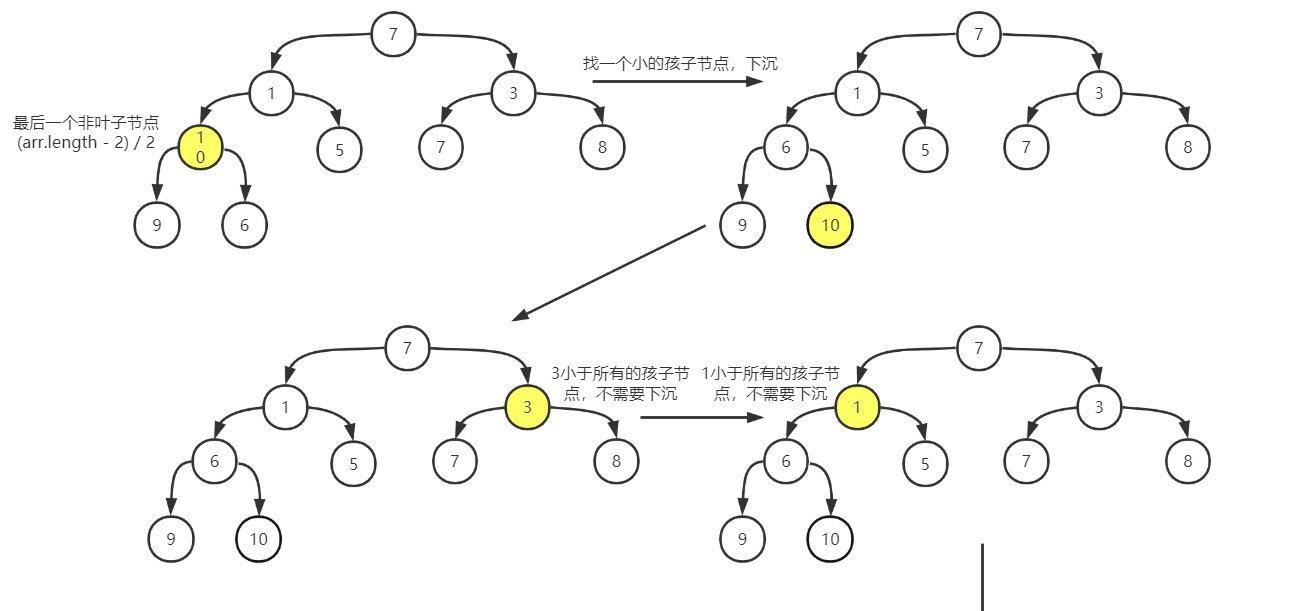徹底搞定堆排序:二叉堆
二叉堆
什麼是二叉堆
二叉堆本質上是一種完全二叉樹,它分為兩個類型
- 最大堆:最大堆的任何一個父節點的值,都大於等於它的左、右孩子節點的值(堆頂就是整個堆的最大元素)
- 最小堆:最小堆的任何一個父節點的值,都小於等於它的左、右孩子節點的值(堆頂就是整個堆的最小元素)
二叉堆的根節點叫做堆頂
二叉堆的基本操作
- 插入節點
- 刪除節點
- 構建二叉堆
這幾種操作都基於堆的自我調整,所謂堆自我調整,就是把一個不符合堆的完全二叉樹,調整成一個堆,下面以最小堆為例。
插入
插入節點0的過程

刪除
刪除節點的過程和插入的過程剛好相反,所刪除的是處於堆頂的節點。例如刪除1
- 為瞭維持完全二叉樹的結構,把堆的最後一個元素臨時補充到堆頂
- 刪除原來10的位置
- 對堆頂的節點10執行下沉操作

構建
構建二叉堆,也就是把一個無序的完全二叉樹調整為二叉堆,本質就是讓所有的非葉子節點一次下沉


二叉堆代碼實現
二查堆雖然是一顆完全二叉樹,但它的存儲方式並不是鏈式的,而是順序存儲,換句話說,二叉堆的所有節點都存儲在數組中

當父節點為parent時,左孩子為2 * parent + 1;右孩子為2 * parent + 2
/**
* @author :zsy
* @date :Created 2021/5/17 9:41
* @description:二叉堆
*/
public class HeapTest {
public static void main(String[] args) {
int[] arr = {1, 3, 2, 6, 5, 7, 8, 9, 10, 0};
Heap heap = new Heap(arr);
heap.upAdjust(arr);
System.out.println(Arrays.toString(arr));
arr = new int[]{7, 1, 3, 10, 5, 2, 8, 9, 6};
heap = new Heap(arr);
heap.buildHead();
System.out.println(Arrays.toString(arr));
}
}
class Heap {
private int[] arr;
public Heap(int[] arr) {
this.arr = arr;
}
public void buildHead() {
//從最後一個非葉子節點開始,依次下沉
for (int i = (arr.length - 2) / 2; i >= 0; i--) {
downAdjust(arr, i, arr.length);
}
}
private void downAdjust(int[] arr, int parentIndex, int length) {
int temp = arr[parentIndex];
int childrenIndex = parentIndex * 2 + 1;
while (childrenIndex < length) {
//如果有右孩子,並且右孩子小於左孩子,那麼定位到右孩子
if (childrenIndex + 1 < length && arr[childrenIndex + 1] < arr[childrenIndex]) {
childrenIndex++;
}
//如果父節點小於較小孩子節點的值,直接跳出
if (temp <= arr[childrenIndex]) break;
//無需交換,單向賦值
arr[parentIndex] = arr[childrenIndex];
parentIndex = childrenIndex;
childrenIndex = 2 * childrenIndex + 1;
}
arr[parentIndex] = temp;
}
public void upAdjust(int[] arr) {
int childrenIndex = arr.length - 1;
int parentIndex = (childrenIndex - 1) / 2;
int temp = arr[childrenIndex];
while (childrenIndex > 0 && temp < arr[parentIndex]) {
//單向賦值
arr[childrenIndex] = arr[parentIndex];
childrenIndex = parentIndex;
parentIndex = (parentIndex - 1) / 2;
}
arr[childrenIndex] = temp;
}
}
結果:
[0, 1, 2, 6, 3, 7, 8, 9, 10, 5]
[1, 5, 2, 6, 7, 3, 8, 9, 10]
總結
本篇文章就到這裡瞭,希望能給你帶來幫助,也希望您能夠多多關註WalkonNet的更多內容!
推薦閱讀:
- Java中數組的使用與註意事項詳解(推薦)
- Java常問面試內容–數組、聲明、初始化、冒泡、多維數組、稀疏數組
- Java中數組的定義與使用
- java基礎的詳細瞭解第四天
- 圖解排序算法之希爾排序Java實現